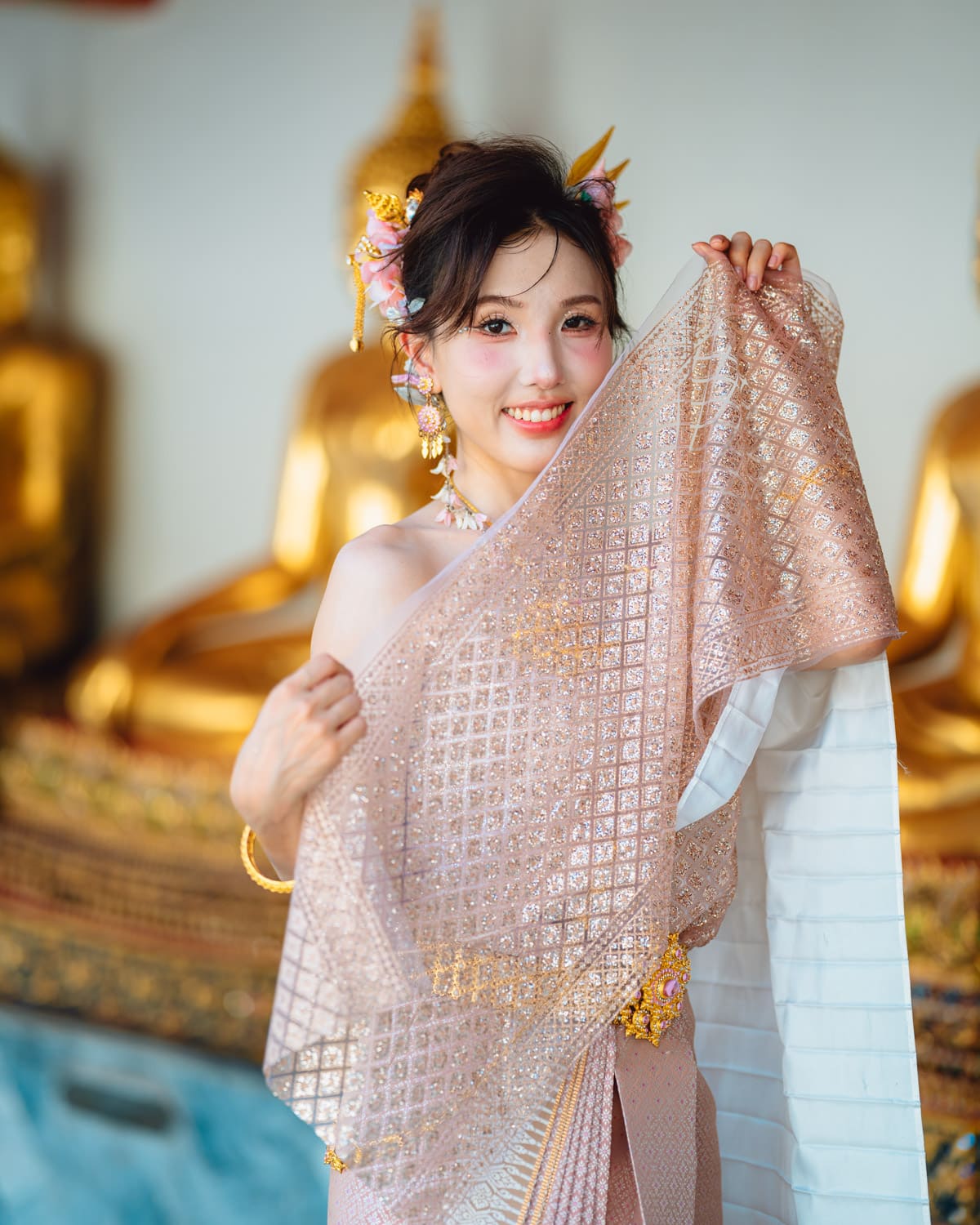Thai traditional attire, with its vibrant history and artistic expression, stands apart as a cultural treasure. While many Asian countries have their own iconic traditional clothing, such as the Japanese kimono or the Indian sari, Thai costumes hold a distinctive charm that reflects the nation’s values, artistry, and way of life. Their uniqueness is not only in their appearance but also in the cultural significance and craftsmanship they embody.
The Soul of Thai Culture in Every Thread
At the heart of Thai traditional outfits lies a profound connection to Thai culture and identity. These garments are more than just clothing—they are a reflection of the country’s history, spiritual beliefs, and social structures. From the choice of fabrics to the way the garments are worn, every element tells a story, connecting the wearer to Thailand’s rich past and vibrant traditions. Unlike other Asian attire, which may prioritize structured designs or symbolic motifs, Thai clothing is fluid and organic, echoing the harmonious rhythm of Thai life.
The Enchantment of Thai Silk
One cannot discuss Thai costumes without mentioning Thai silk, a cornerstone of their uniqueness. Thai silk is celebrated for its shimmering texture and vivid colors, achieved through meticulous craftsmanship passed down through generations. Handwoven in regions like Isan in northeastern Thailand, Thai silk embodies a rustic elegance that sets it apart from other Asian fabrics. While Japanese silk may be prized for its precision and Korean silk for its softness, Thai silk’s slightly raw texture and natural dyes give it a character that is unmistakably Thai.
Regional Variations that Highlight Diversity
Thailand’s regional diversity adds another layer to the uniqueness of its traditional attire. Each region has its own distinctive styles, influenced by local customs, climate, and history. In the northern regions, such as Chiang Mai, outfits often feature warm tones and intricate patterns inspired by the Lanna Kingdom. In the southern provinces, lighter fabrics and breezy designs cater to the tropical climate. The central plains, home to the capital, Bangkok, showcase refined and formal designs befitting the region’s historical ties to the monarchy. This regional variation provides a richness and adaptability that stands out when compared to other nations where traditional attire is more standardized.
The Beauty of Draping
One of the defining features of Thai traditional outfits is their focus on draping. The chong kraben, a wrap-around garment resembling a sarong, exemplifies this. For women, the pha nung, a long skirt draped elegantly, and the sabai, a shoulder cloth, are staples of traditional attire. This emphasis on draping provides Thai clothing with a flexibility and fluidity that differs from the structured designs of, for example, the Japanese kimono or the Korean hanbok. Each drape is a work of art, showcasing the wearer’s individuality while maintaining cultural integrity.
Colors with Meaning
Colors in Thai traditional attire are not chosen at random—they hold deep cultural and spiritual significance. Certain hues are associated with days of the week or auspicious events, reflecting Thailand’s Buddhist heritage and belief in the power of symbolism. For example, yellow is often worn on Mondays to honor the King, while gold is a popular choice for ceremonies, representing prosperity and good fortune. This intentional use of color adds a layer of meaning to Thai costumes, making them more than just visually striking.
Intricate Embellishments and Accessories
Accessories play a vital role in completing the traditional Thai look. From ornate belts to delicate gold jewelry, each piece enhances the outfit while reflecting the wearer’s social status or the occasion’s significance. The pha khao ma, a versatile cotton scarf, is a practical yet decorative accessory often incorporated into daily wear. These additions, combined with the stunning embroidery and handwoven patterns found in many garments, contribute to the intricate beauty of Thai costumes, setting them apart from simpler traditional attire in other parts of Asia.
Royal Influence on Thai Fashion
The Thai monarchy has historically played a significant role in shaping traditional clothing. The Chut Thai Chakkri, a formal outfit for women, is inspired by royal attire and remains a popular choice for weddings and formal events. King Rama V, in particular, had a profound influence on modernizing Thai fashion, blending traditional elements with Western styles. This royal connection gives Thai traditional attire a sense of grandeur and prestige that resonates even today.
Practical Elegance for Every Occasion
One of the most distinctive features of Thai clothing is its adaptability. Whether for everyday wear, religious ceremonies, or grand celebrations, Thai attire can be styled to suit any occasion. This practicality contrasts with the more ceremonial nature of traditional outfits in countries like Japan, where kimonos are reserved for special events. Thai clothing allows wearers to feel both comfortable and elegant, making it a living tradition rather than a relic of the past.
Festivals and Celebrations: A Showcase of Thai Attire
Thai festivals provide the perfect opportunity to witness the beauty of traditional costumes in full splendor. During Songkran, the Thai New Year, people don vibrant and colorful outfits that reflect the festive spirit. Loy Krathong, the festival of lights, sees participants wearing elegant silk dresses as they release floating lanterns onto the water. These celebrations highlight the role of Thai clothing in preserving and celebrating cultural heritage, offering a stark contrast to other Asian festivals where traditional attire might be less prominent.
The Role of Tradition in Modern Thailand
Despite the modern influences shaping Thai society, traditional attire remains an important aspect of daily life and special occasions. Temples, weddings, and royal ceremonies often require participants to wear traditional clothing, keeping the practice alive. This blend of tradition and modernity gives Thai attire a timeless quality, ensuring it remains relevant and cherished.
A Sustainable Fashion Legacy
The emphasis on handcrafting and using natural materials makes Thai traditional attire a sustainable choice in a world dominated by fast fashion. Local artisans continue to produce fabrics using age-old techniques, ensuring that every piece is unique and environmentally friendly. This focus on sustainability adds a meaningful dimension to Thai clothing, distinguishing it from mass-produced garments found elsewhere.
Experience the Uniqueness of Thai Costumes with Siam Crown
For anyone looking to immerse themselves in the beauty of Thai traditional attire, Siam Crown offers an unparalleled experience. Our collection features authentic Thai costumes crafted with care and attention to detail, perfect for weddings, festivals, or cultural events. Whether you’re exploring Thailand’s heritage through a photo session or dressing for a special occasion, our rental services ensure you can experience the elegance of Thai culture firsthand. Visit Siam Crown today and discover what makes Thai costumes truly unique.



